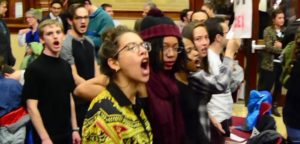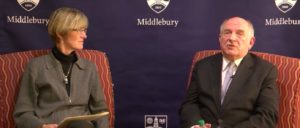 In February of 1943 C. S. Lewis delivered three evening lectures at King’s College in Newcastle. Later that year the lectures were published in book form under the title of the third: The Abolition of Man. Over time Lewis came to regard this slender volume as his most significant work. It’s very short, only 91 pages plus an appendix. You could read it in an evening–but don’t. It’s incredibly packed: every sentence could be pondered over or discussed in an evening’s literary circle.
In February of 1943 C. S. Lewis delivered three evening lectures at King’s College in Newcastle. Later that year the lectures were published in book form under the title of the third: The Abolition of Man. Over time Lewis came to regard this slender volume as his most significant work. It’s very short, only 91 pages plus an appendix. You could read it in an evening–but don’t. It’s incredibly packed: every sentence could be pondered over or discussed in an evening’s literary circle.
Lewis described the third volume of his Space Trilogy, That Hideous Strength, as “a ‘tall story’ about devilry, though it has behind it a serious ‘point’ that I tried to make in my Abolition of Man.” The point was that humanity is in danger of becoming inhuman.
The first essay of AoM, “Men without Chests,” raised the alarm about certain educational trends. He begins with Exhibit A: a literature textbook sent to him by an educational publisher who was probably hoping for an endorsement. Instead of a favorable blurb, the volume got to go down in history (though anonymously) as the notorious Green Book by “Gaius and Titius,”* educated barbarians who were contributing to the gutting of national character. G & T had bought into logical positivism, which generally holds that a statement has meaning only if it can empirically proved or objectively demonstrated. What we today call “values” (and an earlier age called “enduring principles”) are meaningless.
As an example, Gaius and Titius reference Samuel Taylor Coleridge’s story about the waterfall. There were  two visitors besides Coleridge at a certain well-known tourist attraction, one of whom said the waterfall was sublime and the other said it was pretty. The poet mentally endorsed Tourist A—“sublime” was the proper value given to such a sight, while “pretty” was wholly inadequate. But G & T informed the young readers that value statements have no objective reality: isn’t one man’s sublime another man’s pretty? Thus, statements about feelings, metaphysics, or religion are meaningless in the public square, and the sooner English schoolboys and girls learn the difference between fact and value (and disregard the latter) the better off we’ll all be.
two visitors besides Coleridge at a certain well-known tourist attraction, one of whom said the waterfall was sublime and the other said it was pretty. The poet mentally endorsed Tourist A—“sublime” was the proper value given to such a sight, while “pretty” was wholly inadequate. But G & T informed the young readers that value statements have no objective reality: isn’t one man’s sublime another man’s pretty? Thus, statements about feelings, metaphysics, or religion are meaningless in the public square, and the sooner English schoolboys and girls learn the difference between fact and value (and disregard the latter) the better off we’ll all be.
Lewis wasn’t buying it. As a classical scholar he could marshal the finest minds in Western tradition—and even Eastern tradition—to support his contention that hearts must be educated as well as heads, that emotion has as great a stake in human progress as reason. While allowing for individual preferences, there are right and wrong ways to feel. There are qualities that should be encouraged and qualities that should be condemned in no uncertain terms. If a man’s emotions are not trained along with his intellect, there will be no arbiter between his brain and his gut (the seat of animal appetite). That’s what the expression “Men without Chests” relates to, along with the much-quoted observation that we’re asking young people to demonstrate those very qualities we’ve educated out of them. “We make men without chests and expect of them virtue and enterprise. We laugh at honour and are shocked to find traitors in our midst.”
* * * * * * * * * * *
In That Hideous Strength (see my post on The Setup) Mark Studdock, his wife Jane, and his colleagues at Bracton College are all victims of this sort of “progressive” education. Jane, immersed in quality literature (though she insists on putting her modern interpretations on it) is a little more sensitive to beauty and virtue. Mark the sociology major is unwittingly swimming with the sharks, for where there’s no objective scale of value—no authoritative word on whether loyalty is preferable to treachery or chastity to unfaithfulness—what’s left is survival of the fittest. Or the coolest, or the trendiest. You may have experienced a scale of value of this sort in high school (especially if you were considered the opposite of cool). If teenagers grow out of this phase it’s relatively harmless in the long run. But Mark clearly hasn’t. Because his education has given him no higher star to steer by, his one guiding light is to come out on top of whatever heap he’s in. He has set aside any real pleasure and enjoyment in things for their own sake; they only get in the way of striving and climbing. During his visit to Cure Hardy with Crosser he feels the unassuming charm of the place. It tugs at his better nature, but he pushes aside charm for the sake of “progress.” Education has almost nibbled his chest away. We see he still has a bit left, but will it be enough?
 After Chapter 4 the action will shift away from the College and its resident Huns, Curry and Busby, but it’s worth taking a last look at these men lacking in the chest department (Chapter Two, “Dinner with the Sub-Warden,” section 1). They’ve become so involved with the process of education that they’ve lost sight of the content, except as it relates to creating soulless young academics like themselves. Feverstone–the epitome of cool, by the way–is on to them: “I see. In order to keep the place going as a learned society, all the best brains in it have to give up doing anything about learning.” “Exactly!” says Curry, before realizing he’s been had. Stamping out approved young minds has become the College’s business, and the educated people of Edgetow, as we’ll soon see, are by far the most gullible.
After Chapter 4 the action will shift away from the College and its resident Huns, Curry and Busby, but it’s worth taking a last look at these men lacking in the chest department (Chapter Two, “Dinner with the Sub-Warden,” section 1). They’ve become so involved with the process of education that they’ve lost sight of the content, except as it relates to creating soulless young academics like themselves. Feverstone–the epitome of cool, by the way–is on to them: “I see. In order to keep the place going as a learned society, all the best brains in it have to give up doing anything about learning.” “Exactly!” says Curry, before realizing he’s been had. Stamping out approved young minds has become the College’s business, and the educated people of Edgetow, as we’ll soon see, are by far the most gullible.
* * * * * * * * * * *
But it appears as though even intellectuals–or many of them–can’t live without honor and virtue for long. The devaluation of value that lumbered to its feet after the first World War, marched through academia throughout the 20th century and spread its poison through public education, has perhaps met its match in passionate political activism. The anti-war, anti-discrimination protesters of the 1960s and 70s demanded the right to feel. There was a right and wrong, only . . . they get to decide what it is. And they get to decide without reference to long-standing tradition, religion, or philosophy. How does that work out? Lewis will ponder the question in the next essay, “The Way.”
______________________________________________________________
*Hereby unmasked (via Wikipedia) as The Control of Language: A Critical Approach to Reading and Writing, published in 1939 by Alexander (“Alec”) King and Martin Ketley. Doesn’t that sound exactly like the title of a paper (almost any paper) published by the Modern Language Association today?



